Well. So. Here we are. Participating in the Food in Jars Mastery Challenge seems like a better reason than most to finally build a dedicated space where I can write about my canning projects. I learn something new about canning and preserving with every recipe, which is one reason I’m so excited about tackling the Mastery Challenge this year.
January’s challenge was marmalade. I’ve flirted with the idea of making marmalade for years, but never actually taken the plunge. Until last week, I had only the vaguest understanding of marmalade, best summarized as, “Involves citrus, takes forever, hard to get right, turns out bitter.” Also, possibly, “Only eaten by Europeans.” So…. umm…. that’s a good place to start, right?
In canning, as in life, I am not a risk-taker. I like to perfect a technique using a tried-and-true recipe before I start fiddling. Usually I set out to preserve a fruit or vegetable because I found a great deal at the Farmer’s Market, or found a recipe that looks spectacular, or because Christmas is coming up and I need to stock my family’s gift baskets. The Mastery Challenge is a great opportunity for me to be a little more adventurous, because the point is to learn instead of to create. So when I stepped into the kitchen last weekend I felt like the Mastery Challenge had given me permission to mess up. (Gee. If only I could apply that concept to everyday life….!)
Also, Memphis is not the best source of variety when it comes to produce. After half an hour of reading about citrus selection and the types of marmalade best made with different kinds of fruit, I decided my recipes were going to be dictated largely by what fruit I could find, and ventured to my favorite store, the Cordova International Farmer’s Market. I came home with blood oranges and UGLI® fruit — which indeed turns out to be, properly, both capitalized and trademarked. Who knew? I bought it on a whim (adventure!) because a Google search indicated it made great marmalade, and because I’m always looking for an excuse to buy weird, unfamiliar fruits. Turns out, ugli fruit is a proprietary variety of Jamaican tangelo. See? I’m learning stuff already, and I haven’t even made marmalade yet!
I decided to embrace the best of both worlds: I’d use Marisa’s published recipe for blood orange marmalade, and experiment with the ugli fruit using the 1:1:1 ratio for whole fruit marmalade (spoiler: this one turned out to be not so great an idea). This actually meant making the experimental marmalade first, because the blood orange recipe called for cutting up the fruit, then soaking it overnight to soften the rinds.
From my reading, I was concerned that the pith was going to be far too thick for the method I was using. But I didn’t have a citrus zest peeler on hand, so I decided to cut away the pithiest top and bottom of the ugli fruit, and pray* that what was left wouldn’t make the marmalade too bitter. I set a pound of fruit in water to simmer until the skins were soft — which took longer than the guidelines indicated, my first clue that this was not going to go well. But I scooped out the innards, sliced up the rind, and charged full-speed ahead! Did you ever have an idea that you knew was bad, but you went right on with it anyway? Yeah. This was like that.
*God has better things to do than fix my marmalade.
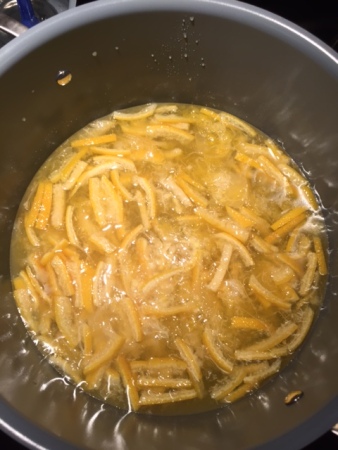
The finished product was beautiful, but I knew even when I portioned it out into jars for processing that it wasn’t right. It had reached 220 degrees and looked primed to set perfectly, based on my experience with jam (note to self: jam set and marmalade set are not quite the same thing). But the guidelines said I should have four half-pints, and I had a scant three. I frequently end up with an extra quarter-pint or so, but to be that far off usually indicates I did something wrong.
My first fear was that I’d overcooked it, hence the loss of volume. But when I opened a jar, the marmalade was runny. Wow. I’m talented. I managed to both overcook AND undercook a batch of marmalade, simultaneously. Y’all, I made Schrödinger’s Marmalade.
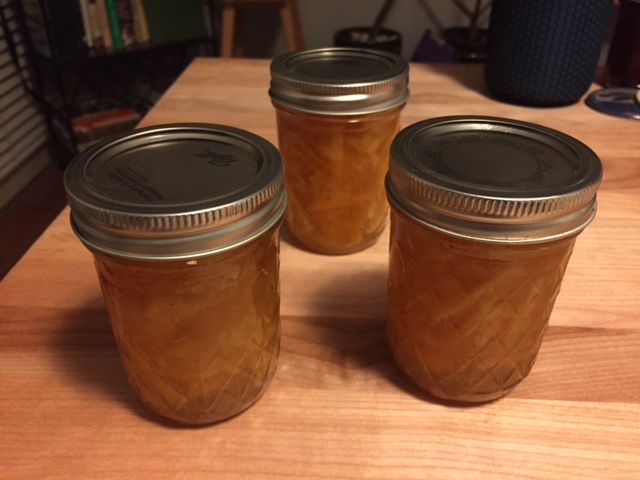
In retrospect, I think the jam was probably not yet set when I took it off the stove. The volume issue is a little more mysterious, but my suspicion is that there are all sorts of surface-area-to-volume issues caused by making whole fruit marmalade with a fruit this BIG. Once I’d boiled down the ugli fruit, the interior was mostly liquid, not pulp, so I think a lot of my mass just … evaporated. Literally. Neither of these things really mattered, since the pith had, as I feared, also left my marmalade unattractively bitter. Attempt 1 was a failure, but not a waste: I learned a ton in the process, and it meant that I was better-armed to determine proper set consistency when I got ready to deal with the blood oranges.
I used this recipe from (roll for surprise) Food in Jars for blood orange marmalade. I actually cut up the fruit while the ill-fated ugli fruit was simmering, then let it soak overnight in the refrigerator. Actually, it soaked three nights, because my week got busy.
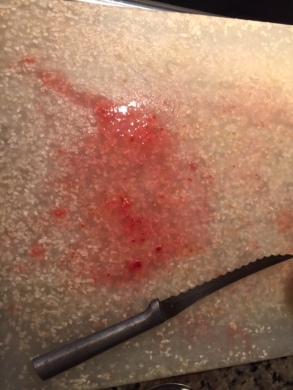
This one went better. By the way, one of the things I am loving about marmalade is the relative simplicity of the ingredients: Fruit, liquid, sugar, BOOM. Of course I’m already looking forward to playing with fruit combinations and other flavors… but I love not needing pectin. Or, at least, usually not needing pectin.
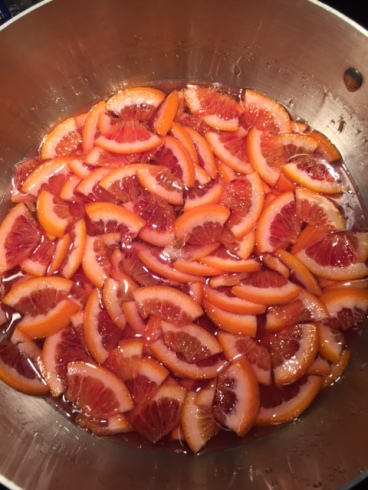
Armed with my ugli experience, I waited a little longer to take my fruit off the heat. I am so used to being able to tell when jam is ready that it felt strange not to trust my eyes; but I used both a temperature check and the plate test to confirm it was time to can the blood orange marmalade. I didn’t want another runny marmalade. The result was three half-pints of beautiful marmalade, with just enough to set aside for tasting the next day. I was afraid this morning that I overcompensated and waited too long – it seemed firmer than I would like when I opened my taster jar this morning – but it spreads well and the extra solidity of the fluid matrix suspends the chunks of rind. (I would not have known how important that is, if I hadn’t seen how hard it was to get the ugli fruit marmalade from the jar to my toast.) While I don’t have a trained marmalade palate, it tastes good too, appropriately bitter rather than overwhelmingly so.
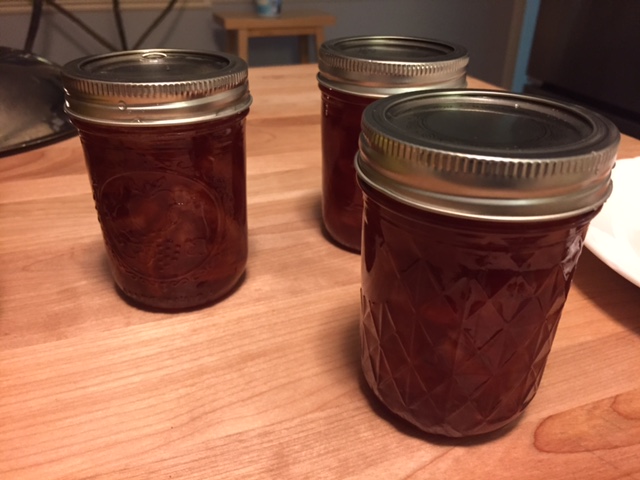
So I can now add marmalade to my repertoire! I feel like I learned a lot in the process, and I’m ready to try some other approaches.
First order of business: Get a zest peeler. The ugli fruit marmalade turned out badly, but the bits without rind in it did taste lovely. I want to try it again with a zest-only approach.

1 Pingback